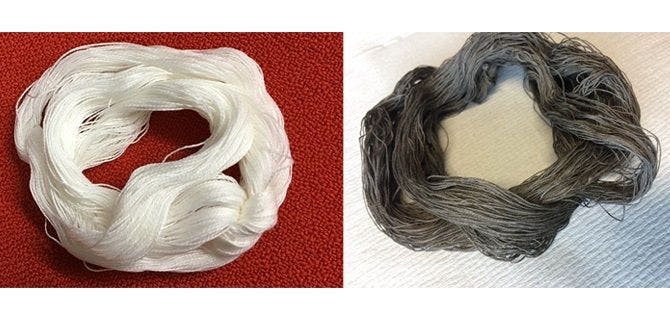A fast and easy method to produce conductive graphene yarn in bulk could open the door to mass production of wearable textile electronics. Researchers made the flexible, washable yarn using an industrial yarn-dyeing process that they say can coat 1,000 kg of yarn in half an hour. Then they knitted the yarn to create a […]

A fast and easy method to produce conductive graphene yarn in bulk could open the door to mass production of wearable textile electronics. Researchers made the flexible, washable yarn using an industrial yarn-dyeing process that they say can coat 1,000 kg of yarn in half an hour. Then they knitted the yarn to create a temperature sensor.
Today’s conductive yarn is usually made of threads coated with copper and silver nanoparticles. Conductive fibers spun from carbon nanotubes or graphene—which are lighter, stronger and more flexible than metal-coated yarns—could lead to softer, more stretchable fabric-based sensors. “Carbon nanotubes are really difficult to synthesize and are expensive,” says Nazmul Karim of the University of Manchester, and while graphene has particularly good electrical and thermal conductivity, fibers of the material tend to be brittle and can only be made in small quantities. Instead, he, Kostya S. Novoselov, and their colleagues decided to coat cotton yarn with graphene.
To make their graphene dye, the researchers dispersed graphene oxide flakes in water and then reduced them using ascorbic acid and sodium hydrosulfite. The flakes of reduced GO, a form of graphene that has oxygen-containing functional groups on its surface, can bond with the cellulose in cotton fibers. The researchers also added polystyrene sulfonate and polyvinyl alcohol polymers to the solution. These attach to the surface of the flakes and keep them from clumping together.
The team dyed a hank of cotton yarn with this solution using a laboratory-scale replica of a commercial yarn-dyeing machine. They soaked the yarn in the dye at 60 °C for half an hour, and then dried it at 100 °C and cured at 150 °C for three minutes. The reduced GO flakes bond to cellulose and become “part of the yarn, not just a coating,” Karim says. This makes the graphene-dyed yarn durable: it retains its conductivity even after 10 wash cycles, whereas yarn coated with unreduced graphene flakes loses conductivity after two or three washes. Encapsulating the yarn with another material—such as a thin, flexible polymer—could make them more stable, he says.
The researchers have used these graphene dyes before to dye already-woven fabrics in bulk. But dyeing yarn with graphene first and then weaving it produces fabrics that are more comfortable and flexible and that look better, which would be important for sensors woven into high-performance athletic clothing, for instance. Plus, dyeing yarn instead of finished fabrics gives researchers more options for making sensors with particular designs and structures.
As a demonstration, the researchers made a small temperature sensor consisting of a few knitted rows of their graphene yarn flanked by rows of silver-coated yarn on either side that act as electrodes to measure resistance. The graphene’s resistance decreased as the temperature increased, allowing the fabric to sense temperature. Karim says the sensor could be easily integrated into a piece of fabric along with an RFID tag that sends the temperature data wirelessly to a phone or computer.
“This is a very forward looking and exciting work,” says Nicholas A. Kotov, a chemical engineer at the University of Michigan. “It is very likely that some threads and fabric of this type will be used in the future.”
This article is reproduced with permission from C&EN (© American Chemical Society). The article was first published on March 20, 2019.
